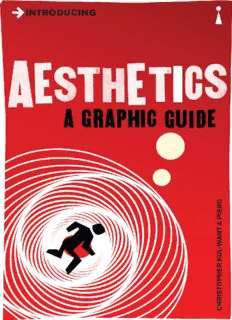
Introducing Aesthetics: A Graphic Guide PDF
Preview Introducing Aesthetics: A Graphic Guide
Published by Icon Books Ltd, Omnibus Business Centre, 39-41 North Road, London N7 9DP Email: [email protected] www.introducingbooks.com ISBN: 978-184831-167-1 Text copyright © 2012 Icon Books Ltd Illustrations copyright © 2012 Icon Books Ltd The author and illustrator has asserted their moral rights Originating editor: Richard Appignanesi No part of this book may be reproduced in any form, or by any means, without prior permission in writing from the publisher. Contents Cover Title Page Copyright What is Aesthetics? The Nature of Experience Socrates and Plato The Power of Poetry Painting as Imitation The Simulacrum Deception is Truth, Truth Deception Aristotle’s Poetics Art and the Audience Art and Reality Catharsis Medieval Aesthetics The Theological Time-bomb The Beauty of Order Thomas Aquinas Beauty and Cognition Art as Religious Instruction Art and Melancholy The School of Night Renaissance Aesthetics Painting as Philosophy The Rise of the Bourgeoisie The Lives of the Artists The Classical Episteme The Subject The Sovereign Eye Et in Arcadia Ego The Imperialist Subject Capitalism and the Other The Enlightenment Kant’s Critical Philosophy The Critique of Judgement The Sublime Universal Reason The Unknowable Hegel and the Universal Consciousness Symbolic, Classical, Romantic The Origins of Modern Aesthetics: Nietzsche, Freud and Marx Nietzsche and the Revaluation of All Values Apollonian and Dionysian Energy The Intoxication of Change Freud and Psychoanalysis Sublimation Marx and the Alienation of Capitalism Art and the Bourgeoisie Aestheticism Modernist Aesthetics Synaesthesia Romanticism Marxist Aesthetics in the 1920s and 30s Lukács and Critical Realism Brechtian Realism Communist Aesthetics Socialist Realism Aesthetics in the Modern Era The Aura The Radical Power of Early Photographs The Fragments of History Theodor Adorno Art After the Holocaust? The Hollowed Subject Nietzschean Aesthetics The Happening of Truth Georges Bataille The Philosophy of Expenditure The Pursuit of the Extreme Psychoanalysis and Aesthetics after the Second World War Language and the Autonomous “I” The Gaze The Fantasy of Control Jouissance Marxist Theories of the Image in the 1960s and 70s Debord and the Society of the Spectacle Lack The Situationist International Détournement Ways of Seeing Modernist Aesthetics: 1940-70 Winckelmann and Lessing Minimalist Art Aesthetics, Contemporary Experience and Postmodernism Fredric Jameson The Rise of the Multinationals Modernist vs Postmodernist Parody or Pastiche? Schizophrenic Culture Antonio Negri and T.J. Clark Postmodernism and Continental Aesthetics The Medium is the Message The Aesthetics of Simulation The Ironies of Postmodern Capitalism Roland Barthes Messages Without a Code The Punctum Julia Kristeva The Chora and the Semiotic Kristeva and Jouissance Feminist Aesthetics and Postmodernism Jacques Derrida Deconstruction Undecidable Art Jean-François Lyotard Newman and Duchamp Gilles Deleuze The Body without Organs Conclusion Further Reading Author’s Acknowledgements Index “BEAUTY IS TRUTH, TRUTH BEAUTY”, – THAT IS ALL YE KNOW ON EARTH, AND ALL YE NEED TO KNOW. So the Romantic poet John Keats (1795–1821) wrote in his celebrated meditation upon mortality and immortality, “Ode on a Grecian Urn” of 1820. But what is beauty, and what is truth? These are some of the questions which aesthetics tries to answer … What is Aesthetics? Aesthetics (the plural form of aesthetic) is derived from the Greek word aisthētikos, from aisthēta, meaning things perceptible by the senses. In the 18th century aesthetics became a branch of philosophy. The German philosopher Alexander Gottlieb Baumgarten (1714–62) first used the word in his Reflections on Certain Matters Relating to Poetry of 1735. Then, in 1750, Baumgarten entitled an unfinished treatise Aesthetica. AESTHETICS IS A SPECIALIST AREA OF INQUIRY CONCERNED WITH PERCEPTION AND SENSORY EXPERIENCE. Today, the word “aesthetic” is frequently encountered in its negative form: “anaesthetic”, which refers to a substance that induces an absence of sensation and an inability to feel pain. Aesthetics has come to be used not just in relation to philosophy, but also in connection with design and fashion (e.g. the designer of a car will refer to its aesthetics, or an interior designer will use the word to refer to the look and style of their designs). In a similar way, “aesthetic” is used in connection with art to describe the sensibility and style of an artist’s work.
Description: